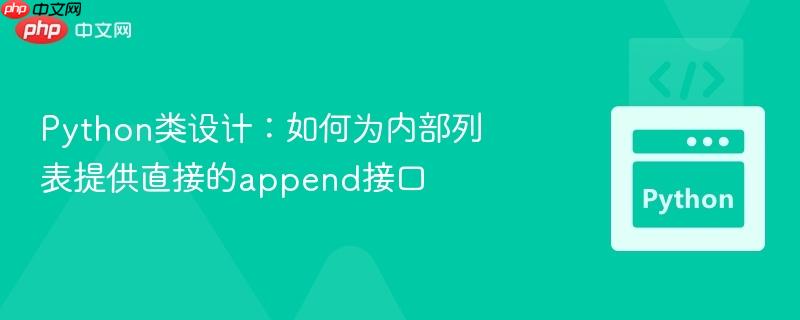
场景分析:简化内部列表操作的愿望
在python面向对象编程中,我们经常会遇到类内部包含一个列表作为其数据成员的情况。例如,一个表示集合或容器的类可能在其__init__方法中初始化一个空列表来存储元素。通常,当我们想要向这个内部列表添加元素时,需要通过访问类实例的属性来操作内部列表,例如 instance.items.append(item)。
class Initialise:
def __init__(self):
self.items = []
# 传统操作方式
list_of_items = Initialise()
list_of_items.items.append("item_a")
list_of_items.items.append("item_b")
print(list_of_items.items)这种方式虽然功能上可行,但在某些场景下,开发者可能希望代码更加简洁直观,能够直接通过类实例调用append方法,就像操作一个普通列表一样:list_of_items.append("item_c")。这种需求旨在提高代码的可读性和封装性,避免直接暴露内部列表的细节。
实现方案:自定义append方法
要实现上述目标,我们不需要寻找任何特殊的“dunder”方法(如__append__,因为Python标准库中并没有这样的特殊方法)。解决方案出奇地简单:只需在自定义类中定义一个普通的append成员方法,并将对该方法的调用转发(或委托)给内部列表的append方法即可。
这种方法的核心思想是方法委托:类实例的append方法接收一个值,然后调用其内部self.items列表的append方法来实际执行添加操作。
class Initialise:
def __init__(self):
self.items = []
def append(self, value):
"""
将值添加到内部列表self.items中。
"""
self.items.append(value)
# 期望的操作方式
list_of_items = Initialise()
list_of_items.append("item_a")
list_of_items.append("item_b")
print(list_of_items.items)通过这种方式,Initialise类的实例现在可以直接响应append调用,从而达到了我们简化代码和增强封装性的目的。
立即学习“Python免费学习笔记(深入)”;
代码演示
以下是一个完整的示例,展示了如何通过自定义append方法来封装内部列表的操作:
class MyContainer:
"""
一个包含内部列表的自定义容器类,并提供直接的append方法。
"""
def __init__(self, initial_elements=None):
self.elements = []
if initial_elements:
for item in initial_elements:
self.elements.append(item)
print(f"MyContainer initialized with: {self.elements}")
def append(self, value):
"""
将指定的值添加到容器的内部列表中。
"""
print(f"Appending '{value}' to the container...")
self.elements.append(value)
print(f"Current elements: {self.elements}")
def get_elements(self):
"""
返回容器的内部元素列表。
"""
return self.elements
def __len__(self):
"""
使容器支持len()函数,返回内部元素的数量。
"""
return len(self.elements)
def __repr__(self):
"""
提供容器的字符串表示。
"""
return f"MyContainer({self.elements})"
# 创建一个MyContainer实例
my_collection = MyContainer()
# 使用自定义的append方法添加元素
my_collection.append("Apple")
my_collection.append("Banana")
my_collection.append("Cherry")
# 验证内部列表的内容
print(f"\nFinal elements in my_collection: {my_collection.get_elements()}")
print(f"Length of my_collection: {len(my_collection)}")
print(f"Representation of my_collection: {my_collection}")
# 也可以在初始化时传入元素
another_collection = MyContainer(initial_elements=["Dog", "Cat"])
another_collection.append("Bird")
print(f"\nFinal elements in another_collection: {another_collection.get_elements()}")运行上述代码,你会看到my_collection.append()直接向内部列表self.elements添加了元素,而无需通过my_collection.elements.append()。
设计原则与注意事项
- 方法委托的本质:这种方法利用了Python的动态特性和方法查找机制。当调用list_of_items.append(...)时,Python会在list_of_items对象所属的类(Initialise)中查找名为append的方法。如果找到,就会执行该方法,而该方法又会进一步调用内部列表的append方法。
- 非“dunder”方法:再次强调,append并非Python中的特殊“dunder”方法。它只是一个普通的方法名,恰好与Python内置列表的方法名相同。这种命名方式是为了保持接口的一致性和直观性。
-
封装的优势:通过自定义append方法,我们可以在添加元素时引入额外的逻辑,例如:
- 数据验证:在append内部检查value是否符合特定条件(类型、范围等)。
- 日志记录:记录每次添加操作。
- 事件触发:在元素添加后触发其他行为。
- 限制操作:例如,如果列表达到最大容量,可以阻止进一步的添加。
- 有限的列表行为:这种方法只模拟了append行为。如果需要模拟列表的更多行为,例如通过索引访问 (instance[0])、切片 (instance[1:3])、迭代 (for item in instance)、删除 (del instance[0]) 等,则需要实现相应的特殊“dunder”方法,如__getitem__, __setitem__, __delitem__, __len__, __iter__等。
- 何时考虑继承或UserList:如果你的自定义类需要完整地模拟Python内置列表的所有行为,并且不打算对列表的大部分操作进行特殊定制,那么直接继承list或使用collections.UserList会是更简洁高效的选择。collections.UserList是一个非常有用的工具,它是一个列表的包装类,提供了所有列表方法,同时允许你轻松地重写或添加自定义行为。
总结
为自定义类中的内部列表提供直接的append接口是一个常见的需求,其实现方式比想象中要简单。通过在类中定义一个普通的append方法,并将其调用委托给内部列表的append方法,即可优雅地达到目的。这种方法增强了类的封装性,简化了外部调用代码,并为在元素添加过程中引入自定义逻辑提供了便利。然而,如果需要模拟更全面的列表行为,则应考虑实现更多的“dunder”方法或利用collections.UserList。






























